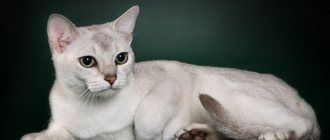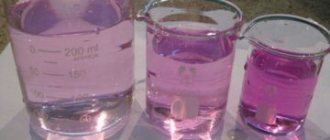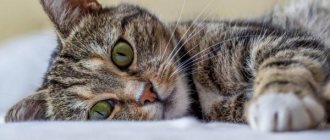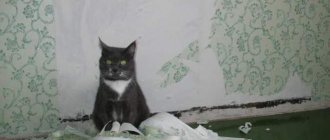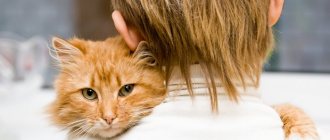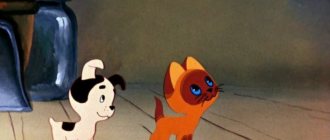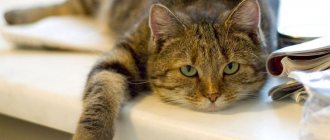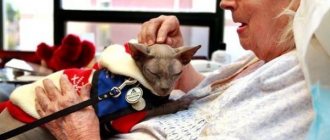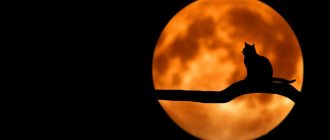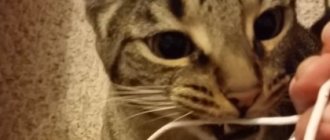People who keep cats at home think about the issue of their proper nutrition. It has long been known that ordinary food is not suitable for these animals, so a large number of specialized foods have long appeared on the shelves of specialized stores. They have a beneficial effect on the health of your pet, the condition of its coat, normalize digestion, and so on. However, choosing food for an animal is not as simple as it might seem at first glance. In this regard, before proceeding with a direct review of the types of feed, we decided to provide some recommendations related to the choice of these products.
Is it necessary to follow the rules for feeding cats dry food?
On each bag of dry food, the manufacturer clearly indicates how much of the mixture is enough to satisfy cats of different ages and weights. The dosage is conditional, but it is still advisable to comply with it, since rickets develops in underfed animals, especially at a young age. Pets that receive more than the daily allowance suffer from obesity. But everything is individual.
Every second owner doesn’t know how to determine whether a pet is overfed or underfed
Note! If your cat likes the food, smells good, and is tasty, she will ask for it all the time.
In order not to deviate from the amount recommended on the package, it is necessary to set the feeding time and frequency. This will also help to calculate the amount of feed for a specific animal per day. So, if a cat is fed only 1-2 times a day for 1-2 weeks, allowing him to consume no more than the norm for age and weight, then after the specified time it will be possible to experimentally understand how much food he really needs. It is recommended to weigh your pet at the end of each week.
Estimated dose:
- reduce if there is food left in the bowl after each feeding;
- increase if the animal has noticeably lost weight.
Note! The norm indicated on the package allows you to calculate only the approximate amount of food.
If the cat is large and weighs a lot due to its breed characteristics, then it will have to be fed more often and more.
Color standards and disqualification
Professional systems of felinologists where the Scottish Fold cat breed is recognized: WCF, CFA, TICA, ACF, ACFA. They all have their own characteristics, but in general there is a set of color standards for the Scottish breed. If an animal does not comply with them, it is disqualified from all breed shows and competitions and cannot be allowed to breed. Of course, a cat disqualified for color can have offspring if the owner does not want to sterilize it. But her kittens will never have a pedigree that is recognized among breeders.
Table of Scottish cat colors and disqualifications.
The variety of colors of Scots is huge. To obtain such a palette, the breeder needed decades of crossings with other breeds similar in genotype. Today, crossing with other breeds is practically not used (unless we are talking about Scottish Folds), since the Scots have already received a stable set of genes necessary to continue their pedigree.
Feeding frequency
The cat takes a break for breakfast, lunch and dinner as often as he is allowed:
- age;
- breed;
- weight;
- health status.
How much dry food to give a dog per day: table
Kittens under 6 months of age are fed dry food 3-4 times a day. At the same time, the cat feeds the babies while they are still very young; they begin giving artificial formula at 2 months. Portions should be small but nutritious; food is chosen taking into account age.
Six-month-old and one-year-old animals are fed 2-3 times a day, and adult cats and cats 1-2 times a day. Typically, the older a cat gets, the less she eats. This is due to changes occurring in the body. The metabolism of older animals slows down, and the gums and teeth cannot process food as intensively as before.
Important! Veterinarians advise feeding cats over 7 years old no more than once a day.
The best shorthaired breeds
Those who cannot decide on a completely hairless cat should take a closer look at alternative options. Hypoallergenic breeds have been bred that have short coats.
Cornish Rex
Cats of this breed have a unique coat consisting of soft curly hairs, closely resembling astrakhan fur. They have no guard hairs, and the entire cover is represented exclusively by undercoat. It falls in a dense wave. These cats are smooth and silky to the touch.
Cornish Rex
The Cornish Rex is a medium-sized cat with a wedge-shaped head and large ears. The eyes are round and bright. The coat color can be different, including spotted. Cornish Rexes are ideal indoor cats. They are calm, rarely get sick, but are prone to overeating. This is worth considering for those who decide to purchase such a cat.
Devon Rex
The appearance of representatives of this breed resembles the Cornish Rex, but they are not considered relatives. The Devon Rex has soft curls of undercoat on its back. The fur itself is small, the cat practically does not shed.
Devon Rex kittens
These are graceful cats with a strong body, a small head and a flat muzzle. They have large round eyes and wide-set ears. Devon Rexes have well-developed limbs, thanks to which the cats have high mobility and jumping ability. Devon Rexes have an easygoing disposition. They have close contact with humans and remain playful even into adulthood.
Feed intake depending on age and activity level: table
The amount of food an animal consumes is related to its age and activity level. So, if a cat is active and young, then he spends a lot of energy. It should be replenished by increasing the calculated amount of feed assigned to him by age. More data in the table:
Walking dogs: how many times a day should you walk by time?
| Age, month | Active, g | Not active (lazy), g |
| 3-6 | 50-70 | 100-110 |
| 6-12 | 200 | 250-300 |
| From 12 | 200 | 250-300 |
The amount of feed also depends on the weight of the animal.
So, a cat that weighs up to 2 kg consumes an average of 25-40 g of food per day. A cat weighing up to 4 kg can eat approximately 55-80 g of food. A pet whose weight exceeds 8 kg consumes up to 140 g of dry mixture per day. Note! To calculate the amount of food for 1 adult cat, add 10-15, or even 20 g of food for every 1 kg of weight. So, if a pet weighing 2 kg or more is given 25 g of food, then a cat weighing 3 kg is given 40 g, a cat weighing 4 kg is given 55 g, and a cat weighing 5 kg is given at least 65-70 g of food.
Nutrition standards for animals
A little about genetics
It is especially interesting how the color of a Scottish kitten is formed and what it depends on. In the genome of this breed, two colors predominate, responsible for the color of the animal - red and black. Anyone can, under certain conditions beyond a person’s control, become dominant. Such a gene suppresses weak ones, which are called recessive. There is also a third gene, the so-called diluent. It is responsible for the degree of pigmentation saturation.
When these genes are combined with each other, the most unusual coat colors of an animal can appear. It is extremely difficult to determine in the first weeks what color a kitten will have in the future. The shade he was born with is not constant and may change as he grows older. In some cases, dramatic changes occur. The change in shade begins at six months and lasts up to two years. The table below shows options for crossing the colors of parents, according to which their offspring inherits the coat color.
How the coat colors of the offspring are crossed.
Material on the topic: how to get a Scottish fold cat.
How much wet food does a cat need per day: table
How many days before vaccination should a cat be given anthelmintic?
The amount of wet or natural food is calculated based on the cat's weight. A pet should not eat more than 7-7.5% of its weight per day. Age and health status are also taken into account.
| Age, weight | G |
| Kittens up to 6 months | 50-150 |
| One year old cats | 150-200 |
| Adult animals up to 4 kg | 300 |
| Animal over 7 years old | 200 |
Rare colors of Scottish cats
You can find a pet of almost any color, but Scotch tortoiseshells are of particular value to breeders. Such individuals have a combination of genes for two primary colors - red and black. For lovers of the breed, gold and silver colors are now in fashion. They are also called precious. Those who are looking at this breed and are going to buy a Scots kitten will be able to choose the color they want - the variations are very rich and varied.
Tortoiseshell Scottish cats.
Features of feeding pregnant cats
The amount of food consumed for pregnant cats is calculated in a special way. During this period, the animal needs additional sources of vitamins and minerals. Not knowing exactly how much a cat should eat and what to feed it, they turn to the veterinarian. But in most cases, she is fed natural food or premium and super premium food (Royal Canin, Perfect, etc.). When choosing food, take into account the presence of products containing:
- proteins;
- vitamins;
- minerals.
Already in the second week of pregnancy, the animal begins to consume approximately 10-15% more feed than usual. There is no need to limit the cat. Starting from the 3rd week of pregnancy, the cat is given 50% more than the usual amount of food. So, if she received 250 g, then during pregnancy she is fed an additional 125 g daily.
Your pet is in dire need of:
- calcium. If there is not enough of it, the kittens will develop poorly, will be born weak, and the cat herself will begin to have problems with her teeth;
- vitamin A. Its lack leads to a decrease in visual acuity, the quality of the coat also deteriorates;
- animal proteins. Without this component, the harmonious development of kittens is impossible;
- vitamin E. Accelerates cell regeneration, is responsible for the condition of the reproductive system, helps to recover after childbirth;
- vitamin K. The lack of this element has a negative effect during childbirth; animals begin bleeding, which cannot be stopped without medication;
- fiber. The cat's intestines begin to work better. This is extremely important during pregnancy.
Important! Shortly before giving birth, a cat may even refuse its favorite food, this is normal. Trying to force feed an animal beyond the norm (plan) is not worth it. It is impossible to change a cat’s diet while bearing kittens, for example, by switching from Kanin to Kitekat food. If this needs to be done, consult a veterinarian.
How to tell if your pet is not hungry
Why is it important?
In nature, cats eat irregularly and sometimes not enough, but they have to move a lot, so they always remain slim. In our houses and apartments, everything happens exactly the opposite: there is no need to spend hours tracking down prey and escaping from enemies, the sofa is warm and soft, and there is always plenty of food in the bowl. This is why many domestic cats are overweight.
Sometimes owners are only touched by this fact, although it is high time to sound the alarm. After all, obesity threatens serious diseases and reduces the pet’s quality of life and its duration.
By following the norm of dry cat food, you can prevent the problem of excess weight or solve an existing one. To do this, you don’t have to weigh yourself and count calories every day, because dry food is very easy to dose. It is enough to correctly measure the norm once on a kitchen scale or with a measuring cup, and then adjust it from time to time.
Normal for a neutered cat
Neutered cats consume less food and need fewer calories. Castration affects hormonal levels, which affects the character of the animal. It becomes calmer and less active, accordingly, it sleeps more and eats more. Often, pets who are decided to be sterilized are diagnosed with obesity. To prevent this, and also to protect the pet from the development of urolithiasis, cats are fed premium and super premium food at the rate recommended by the manufacturer and the veterinarian, who knows exactly how much a cat should eat.
To saturate an adult animal, 150–200 g of feed per day is sufficient. If the animal shows signs of obesity, the portion is reduced by 50-70 g, excluding additional feeding and distribution of goodies.
Note! After castration, cats are not recommended to be given foods rich in phosphorus and magnesium, which means they are prohibited from consuming fish and other foods containing these elements. This also applies to dry food, the packaging of which contains an indication of the presence of fish.
How much food to give a purebred cat
Price for hypoallergenic cats
It is unlikely that you will be able to purchase an animal that will not cause allergies cheaply. It is important to buy a cat from breeders who guarantee the purity of the breed. Prices in nurseries vary. The final cost always depends on the class of the kitten. Pets for home care are cheaper than show-class pets used for breeding. On average, the price range is as follows:
- The price for a kitten of the Siberian breed starts at 7,000-10,000 rubles.
- Devon or Cornish Rex cost at least 12,000.
- Those wishing to purchase a Sphynx need to be prepared for a price tag of 15,000 rubles, and completely naked options usually cost more and are valued higher.
- The price for an Oriental breed kitten starts at 10,000-12,000 rubles.
- The cost of a Balinese cat for home keeping is 15,000 rubles.
It is not recommended to take purebred cats from your hands - you will receive complete information about the animal only from the breeder
It is important to understand that a cat quickly becomes attached to a place and a person. You should not purchase an animal unless you are sure that allergies will not occur. If you really want to have a pet, it is best to first familiarize yourself with the list of hypoallergenic breeds, choose a nursery and test the animal’s saliva for the presence of dangerous proteins.
How to tell if your cat has enough food
A cat that is fed up with food will never lick the bowl or ask for more. You can understand that your pet has enough food based on other signs:
- the animal's fur is smooth and shiny;
- the animal behaves as usual, showing neither apathy nor aggression;
- the eyes are clean, tears and unpleasant-looking smudges do not collect in the corners;
- the animal eats well;
- The cat often empties its intestines, it does not have constipation or flatulence.
A well-fed animal actively participates in games and does not try to steal even the most unappetizing pieces from the table.
If the quality or quantity of food is in doubt, the cat needs to be squeezed, checking whether its ribs are protruding, how sharp the ridge is, and whether it sticks out from under the skin.
Important! The absence of obvious signs of exhaustion and the simultaneous absence of any diseases in the cat indicates that the animal is satiated, has enough food and should not be fed more than the daily norm of food for cats by weight, age and breed.
Why does one food seem tasty, while another doesn’t excite your pet’s admiration?
What does it mean to be a hypoallergenic cat?
The body of any cat, regardless of its desire, produces dangerous proteins. The fundamental difference lies only in their quantity. The fewer enzymes there are, the more rights a cat has to be considered “safe”, fitting the definition of “hypoallergenic”.
Scientists involved in the study of hypoallergenic breeds have identified a relationship between the quantitative content of “harmful” allergens and:
- age of the cat;
- gender of the animal;
- breeds;
- color
Therefore, future owners would do well to take note of the following facts:
- the glands of a castrated cat secrete significantly less Fel D 4 and Fel D 1 proteins than contact proteins;
- Compared to an adult, the intensity of enzyme secretion by the kitten’s body is lower;
- The dark color of a cat indicates a high content of allergens. An animal with light fur is considered safer in this regard;
- It is the cat, not the cat, that appears in the house that will increase the risk of allergic reactions.
How to tell if your cat doesn't have enough food
If a pet does not have enough food, it behaves restlessly, regularly checks the bowl, and changes in appearance. Thus, malnourished cats, especially those who are nursing kittens, change their appearance dramatically and very quickly. Their ribs begin to protrude, their spine becomes visible, and even a significant amount of fur does not hide their thinness. In an emaciated cat whose nutrition is not organized correctly:
- there is lethargy in all movements;
- signs of vitamin deficiency appear - watery eyes, inflammation of the mucous membranes, dandruff, hair loss;
- the figure takes on an hourglass shape;
- The fat layer on the ribs disappears.
For your information! A 10% loss of previous body weight is already considered critical. A pet that does not receive the amount of food it needs may get sick.
If the owner cannot decide on his own whether the cat is skinny or not, it is better to take the animal to the veterinarian and consult with a specialist about its further diet.
It is useful to create a menu for the day, and if the cat eats exclusively dry food, then you need to weigh it before each feeding. This will help resolve the issue of how many spiders to give a cat per day, and gain confidence that the pet is really getting enough nutrition and has enough of everything.
When an animal is hungry, it constantly begs for food.
Hypoallergenic cats: myth or reality?
Cat breeders immediately warn that there are no breeds that do not cause allergies. To understand this issue, you need to understand what exactly causes increased susceptibility. Research confirms that a special protein, Fel D1, is actively synthesized in the cat’s body. This compound causes allergic reactions in humans.
Allergies are caused by a specific protein, which is produced in different quantities in all breeds.
Some breeds produce a lot of this protein, so the likelihood of developing allergies will be high. As for hypoallergenic cats, the production of Fel D1 in their bodies is slow. Its concentration will be lower, therefore the likelihood of developing unpleasant symptoms upon contact with an animal decreases.
It is generally accepted that allergies are caused by animal fur, but the protein, which is dangerous to humans, is usually found in biological fluids, including urine and saliva. Thick hair only helps the allergen spread faster throughout the room.
The thicker the fur, the faster allergens spread throughout the room.
This fact suggests that even those with thick fur can theoretically be hypoallergenic, provided that these cats produce little Fel D1 protein.
What determines a cat's appetite?
Cats are picky eaters. Most animals living in a house and eating a certain type of food refuse new treats, stubbornly following their habit. Some are so stubborn that they don’t eat for 3-4 days or even a week. At the same time, this does not affect the well-being of a well-fed cat, but the owners feel extremely uncomfortable, since all this time the pet demands the treat it likes. A cat's appetite largely depends on:
- the smell of food. Knowing this, many manufacturers of economy-class food flavor them with a large amount of flavoring substances. For this reason, a cat will prefer cheap Whiskas to expensive premium food (Perfect, Proplan, Purina);
- room air temperature. In summer, animals drink more water and eat less. This is normal and is not considered a deviation or a sign of any disease;
- feeding areas. The cat's bowl should remain in one place the entire time the pet lives in the house. Constantly moving the bowl from the kitchen to the room and back causes discomfort to the animal and negatively affects its appetite;
- cleanliness of the bowl. Cats are clean. A bowl in which leftover food sours and rots causes them to have an aversion to food. An animal is capable of refusing food if little attention is paid to the cleanliness of the dishes in which it is placed;
- start of heat. If a female cat is approaching heat, this will affect her appetite. Animals stop eating, sleep or rush around the house, drink water, but do not eat. The hunger strike lasts at least 1 week. Yard animals spend all this time searching for a mate, not even responding to the call of the owner who plans to give them food;
- stress resistance of the body. If the cat was recently given into good hands or transported to a new habitat, it most likely will not eat anything for 2-3 days.
Important! A cat infected with fleas or internal parasites (roundworms) also stops eating well. Such animals often refuse even their favorite types of treats. Appetite disappears in animals suffering from problems with the digestive system, pain in the teeth and gums, inflammation and wounds. If the exact reason for refusing to eat is unknown, the pet is taken to a veterinarian for an examination.
An overeating cat will always have a very swollen belly.
Dry food is a real salvation for busy people who dream of having a pet. This is a shelf-stable product containing all the vitamins and minerals necessary for the animal’s body. But the amount of feed must be calculated correctly. A malnourished cat loses weight, is unable to bear offspring, and can become seriously ill. An overeating cat begins to have problems with excess weight, cardiac and digestive systems. The approximate amount of food per cat per day is indicated on the packaging by the manufacturer, but it is better to ask your veterinarian about how much food to give your cat.
The best breeds with a minimum of wool
Those cats that have no hair at all will also be hypoallergenic. These are the so-called hairless or hairless animals. Not everyone likes such breeds, but most of them are famous for their high intelligence and docile nature.
Canadian Sphynx
This is one of the first breeds of hairless cats to appear. If a person is prone to allergies, then it is worth choosing this one. Canadian Sphynx cats are not like other cats. Their peculiarity is the complete absence of standard wool. Instead, there is fluff, so the cat will feel velvety to the touch. The body of the animal is rounded, the skin forms many folds. Its shades can be different - plain or with spots. The “Canadians” have a long, whip-like tail, pointed at the end.
Canadian Sphynx
The animal's face also looks unusual. The Canadian Sphynx has large round eyes, clear cheekbones, and wide-set ears. There should be no whiskers, but whiskers are present above the eyebrows.
Canadian Sphynx cats have elevated body temperatures. This is considered the norm for animals without fur. For an adult cat, the normal temperature is 39-40°C. Kittens have an even higher temperature - 42°C.
Despite their strict look, Canadian Sphynx cats easily get along with people
Canadian Sphynx cats are considered ideal pets for families with small children. These cats are affectionate and friendly. They don't get angry, don't hiss, and don't scratch. They are not characterized by aggressiveness. These are mobile and active animals that become attached to humans.
Don Sphynx
This is another option for cats without hair, and, unlike Canadians, these sphinxes may have no hair at all. To purchase a completely hairless cat, you need to pay attention to the type that the breeder will name. There are 4 of them in total, and they are discussed in more detail in the table.
Table. Types of Don Sphynxes
| Type | Description |
Naked | There is no wool or fluff. The cat's skin is absolutely smooth. The epidermis feels like a rubber coating to the touch. |
Flock | The animal's skin is covered with many short, straight hairs. They are soft and thin, almost invisible. Skin feels like a peach |
Velours | The skin is covered with hairs 2-3 mm long. They are clearly visible to the naked eye. Hair may fall out, leaving the skin surface smooth |
Brush | These cats have hair, but it is sparse, hard, crimped, and lies tightly to the body. |
The Don Sphynxes are visually different from the “Canadians” in that they have a more massive build, their skin has many more folds, and their ears are narrower and set higher. The eyes of the Don Sphynx are narrow, elongated, and have a stern look.
Don Sphynx kittens
The Don Sphynx is an excellent option for apartment living. This cat does not shed and does not smell. Cats practically do not mark their territory. These are smart cats that are litter trained without problems. They become attached to their owner, but can be touchy.
Peterbald
This breed is considered young. She was bred in Russia by crossing an Oriental cat with a Don Sphynx. The Peterbald (Petersburg Sphynx) is an elegant and slender animal. They have a straight profile, large ears, and almond-shaped expressive eyes. Peterbalds' skin varies, but all colors are considered hypoallergenic. Among the representatives of the breed there are all types characteristic of sphinxes:
- brush;
- flock;
- velours;
- naked.
St. Petersburg sphinxes
There are also straight-haired varieties. Such kittens are born in the absence of the gene responsible for hairless skin. Outwardly, such cats resemble their closest relatives - Balinese or Javanese.
The Peterbald is a companion cat. This is a calm and kind animal that requires the company of other pets or people. These are unforgiving and non-aggressive cats.
Advantages and disadvantages of various types of fillers
Let's look at the pros and cons of different types of fillers.
The mixture may retain its structure when excrement comes into contact with it, or it may form into clumps. Lump-forming fillers, when urine comes into contact with them, form into conglomerates that are easily removed from the tray, without throwing away unused filler.
Absorbent materials must be completely replaced.
The advantages of clumping filler include:
- economical consumption (you can throw out only lumps and solid excrement as needed, after which you can pour a little filler into the tray);
- these types of fillers retain odor well;
- convenience (using a special spatula to remove lumps from the tray is very easy).
Such fillers are very convenient if there is only one pet in the house. If several cats live together, it is better to choose absorbent litter. They are made from environmentally friendly materials, are safe, eliminate odor and moisture, retaining them while they are in the tray.
However, very clean cats may refuse to reuse the litter box, even if not all of the litter has been used, because it does not hold the odor well enough.
Let's look at the pros and cons of fillers made from various materials.
Mineral
This material is very common, as it has undoubted advantages and a relatively low price (depending on the manufacturer). It retains odor well and compares favorably with sawdust in this property. For the production of mineral filler, raw materials of both natural origin and synthetic materials are used.
Cheaper mineral mixtures are very dusty, as the granules rub against each other, forming very small particles. Such fillers are not recommended for use on kittens and animals prone to allergic reactions, as dust can harm them. And digging around in a dusty column is not very pleasant. More expensive and high-quality products have greater density and generate less dust.
Silica gel
This material is the most innovative, practical, but also expensive. It is the latter quality that prevents such fillers from displacing all other types of this product from the market. Otherwise, it is the most economical and fairly safe material.
Silica gel fillers belong to the absorbent class, and you have to clean the tray infrequently: once every few days. You can completely change the filler every two or three weeks.
Among the disadvantages, we can note the fact that not all cats like the sounds that the gel particles make when the animal digs in the tray. The material may also have an odor that is invisible to humans, but can be detected by the sensitive nose of a cat.
The cat may not like the smell of his litter box.
The material has been used for the manufacture of cat litter relatively recently, so there is no reliable information about its safety.
Woody (and its subspecies corn)
For production, sawdust is used, compressed into granules of various sizes. This is an environmentally friendly material, safe, and does not provoke allergic reactions in either animals or their owners. It's easy to clean, you can even flush it down the toilet. Prices for wood fillers are the most affordable.
Wood filler does not remove odors very well. In addition, the cat can spread particles of it throughout the house, as they stick to its paws.
Corn cob mixtures are more expensive than regular wood mixtures. They hold cat scents better. They are very light in weight, and a cat working intensively with its paws can scatter the granules around the tray.
Mr. Cat recommends: the most popular and high-quality products
We present an overview of the best cat litter available in our stores.
Among mixtures of natural materials, consumers prefer the following brands of wood fillers:
- Kuzya;
- Clean paws;
- N1 Naturel (green tea);
- CAT'S Best ECO Plus.
Innovative and high-quality silica gel mixtures:
- Cat step;
- Pretty Cat Purity Crystals;
- Siberian cat (elite).
The best clay fillers:
- Zoonic;
- Barsik;
- Pi-Pi Bent Classic;
- Ever Clean Fast Acting;
- Fresh Step Extreme Clay.
The television program “Test Purchase” compared different types of fillers. There, experts and ordinary people evaluate the product according to various parameters.
The product called Pretty Cat was recognized as the highest quality and most popular. Second place went to the “Clean Paws” litter, and third place went to the Catsan brand.
You need to choose the best litter for a cat, because it is not just a pet, but for many people a real friend. Therefore, it is necessary to take care of the safety of the material and the absence of toxic elements in it.
The animal needs a filler that is as close as possible to natural conditions, where it can dig with pleasure and without harm to its health.
How it works
There are two types of filler, differing in their principle of action. The components either absorb secretions and odors, or form dense structures in the form of lumps with urine, which are easily separated from the main mass.
Absorbent filler
Convenient for cats as it quickly absorbs large amounts of liquid. Manufacturers use natural raw materials that are safe for animal health: special types of clay, corn, sawdust, and pulp.
Most manufacturers do not add flavorings, but the composition may include soda, activated carbon or silver ions - these components significantly improve the characteristics of the absorbent filler.
It is inexpensive, but requires more frequent replacement compared to clumping ones, and regular disinfection of the tray itself. There is an advantage to this - with frequent washing, the risk of pathogenic microorganisms multiplying in the contents of the cat litter is much lower.
Important! Opt for an absorbent one if your pet has access to the outdoors (you walk it on a harness or take it to the dacha). Absorbent litter is the best option when there are several cats living in the house.
clumping
This type of brand is more popular, since the clumping filler is convenient for owners. For its production, bentonite is often used, a clay mineral with excellent absorption properties. Wood, paper and some other materials are also used as raw materials.
Why do cat owners love clumping litter? In addition to the obvious advantages - cost-effectiveness and ease of cleaning, some brands have special additives that change color depending on the composition of the urine. So, if the animal is sick, and there are no external symptoms yet, the unusual color of these additives will allow the owner to seek help from a veterinarian in time.
A number of manufacturers include substances that change color when exposed to urine. The purpose of such additives is to clearly define the boundaries of the lump. Therefore, the pet owner can save money by not throwing away clean litter. Many brands contain a variety of fragrances - components that are useless for cats, but pleasant for owners.
Cost of microchipping a cat
global $ads_google;
//data-ad-slot=”2475549904″ $ads_google = empty($ads_google) ? false : true; ?> if ($ads_google == false) {?> $ads_google = true; ?> } ?> Now it's time to discuss how much it costs to microchip your beloved pussy. The cost of microchipping a cat depends on several factors. The manufacturer brand, the type of microchip, as well as the location of the procedure play a role - the doctor can come to your home along with the necessary equipment. This will significantly save time, but also raises the price of the service.
If a chip is implanted in a clinic, the average price is 2,000 rubles both for the procedure itself and for processing all the data on the animal and registering information.
